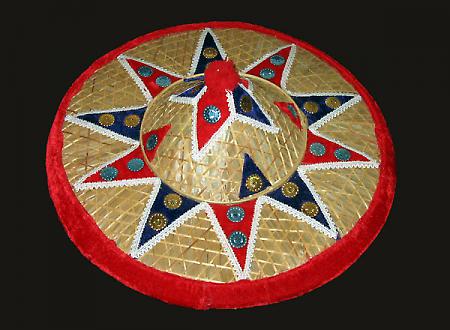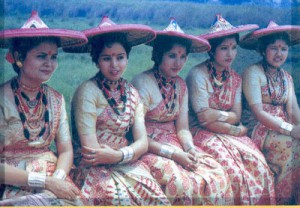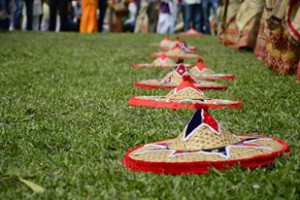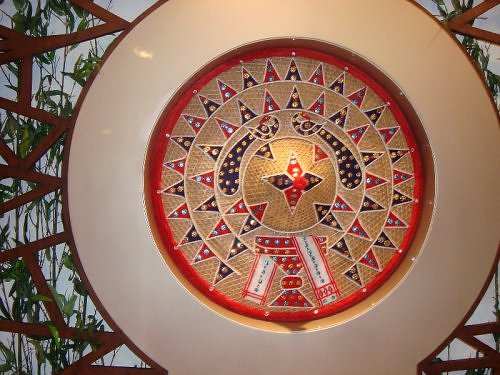
Japi Handicraft
Japi is a trademark of the handicrafts built in Assam. It features a hat which bears the structural and designer properties of the traditional belongings of Assam. It is composed of closely knit cane staff bundled together with clusters or “japs” of the leaves of the “tokou”- a palm tree. It is mainly used as a decoration for the head to act as a protection for head and hair, and also as ceremonial or cultural attire.
Origin and History
Traditionally, it is used to be adorned by the farming communities of Assam as it was a large and helpful accessory to protect the farmers during their daylong work and exposure to harsh weather. The Japis used by farmers were called Haaluwa Japi and the ones the shepherds and cowboys used were named Gorokhiya Japi. They were a custom of the royal members of ancient Assam as well. Japi also finds reference in the compositions of the Assamese songs.
It originated during the arrival of the renowned historical world traveler Hiuen Tsang in Assam. Since then, it was had been adopted as a sign of attachment to the vast Assam culture. Therefore, in the social communities and cultural aspects of Assam, it is a traditional icon and possession. Since the progress of Assamese culture, it has spread as a sign of social respect all across the economic diversion of Assamese communities.
Style
The structure of the making of Japi basically involves the usage of cane staff and tokou leaves all tied together. A structure of bamboo having six appendages of cane stuck to it is used. The sticks are placed at particular angles and are equipped with a space on the top to accommodate a cap resembling structure. There are a couple of rings which are cane sticks bent into a circle. Following this progress, the entire structure is then wrapped up uniformly by dried and shaped leaves of the Tokou. The resulting assortment forms the complete Japi hat.
Influences Over The Years
Over the years with the communal progress, it has been promoted from the exclusivity of being used by farmers and cowboys to the communities of higher strata of Assamese society. It is gifted as a crown to a visitor which marks the welcome ceremony. Recreationally, it is used as a head dressing by the Bihu dance performers, where it may be further decorated and adorned with colors and flowers. It is also included in religious purposes.
Innovations
As the requirements and the domain of usage of the Japi have been under constant modification since the ancient era, the hat has undergone numerous transitions and modifications among the society. Earlier, Japis used to be very spacious while simultaneously having a large spread while worn upon the head. This was to protect the person from tough weather conditions. But later, with the social upliftment of the Japi, it underwent a reduction in span accompanied by a nice change or addition of coloring contrasts.
Occasion Dressing
The phenomenon of being a handicraft renders a powerful impact of the Japi upon the growing domain of its users in social Assam. This adds to the advantage of modifying and introducing other structural changes in the Japi, apart from its size. This makes it more presentable for any arising social situations. Accordingly, in festivities, the Bihu dancers use Japi as a richly colored decoration for the head. In other occasions, performers wearing bright clothes or dresses take up varying shapes of colored Japis. Moreover, the decorated Japis are also used as show pieces and mementos.
Global Influence
With the increasing popularity of Japi in Assam as well as in our entire country, it is introduced daily into newer dimensions of social and cultural domain across the diversities. In exhibitions and communal markets which are open to be availed by national and international visitors, it has been of significant influence to communal dressing etiquette’s as well as it has been accepted as an inclusion in various textile business products. Moreover, association with Japi has brought continual profit to the other small scale cottage industries globally.
Chronicles of the Future Foretold
The Japis are finding a very wide appreciation in the domestic and foreign market of purchase and exhibitions. As such the Japi crafters are being made more versatile and skilled due to the increasing demand. Consequently, the Japi making industry and the domestic groups of craft making are gaining more recognition, thus bringing Assam Handicraft industry a major profitable industry with time.
Interesting Facts and Comparisons
- The Japi manufacturing business has long been a traditional creation of sole Assam. This has led to various associations of other small scale handicraft agencies and thus together the recognition has even widened globally.
- Japis are so very demanded and treasured that every design and structure of all the available Japis have been classified as unique landmarks in the development of the Japi handicraft.
References
Categories: Attires, Costume Accessories



